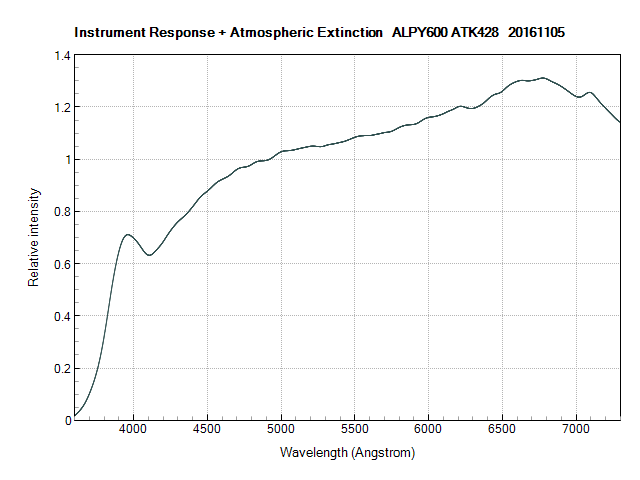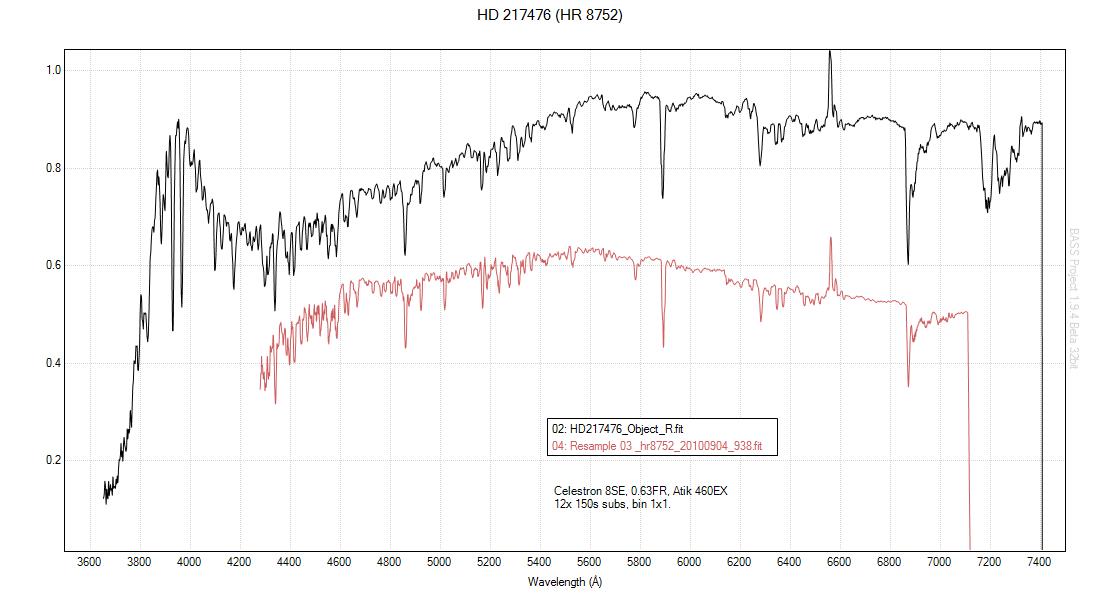› Forums › Spectroscopy › New obs (2)
- This topic has 3 replies, 2 voices, and was last updated 8 years, 11 months ago by
 Robin Leadbeater.
Robin Leadbeater.
-
AuthorPosts
-
27 January 2017 at 10:58 pm #573679
 Kevin GurneyParticipant
Kevin GurneyParticipantSo this was a serendipitous find.. Being new to this game, I was
naively selecting some examples of stars from each main class, around
mag 5, and visible from my (somewhat limited) horizon. I chose this
as my ‘class G’. The resulting spectrum (black line in attachment) was
odd to say the least. It has emission in Ha and strong sodium
absorption… I then found this was in fact a ‘yellow hypergiant’; extremely
luminous, with varying temperature and strange things going on around
Ha (although I cant resolve that here). It appears to have attracted a
lot of interest in the professional community over the last 40 years
or so…Anyway, I eventually tracked down Christian Buil’s rendering of this
using a mighty eShel device.. To make this comparable with my humble
Alpy spectrum I low-pass filtered it and it is shown as the red line in
the attachment.So its reasonably comparable, but the blue end is extended for me and
this shows something odd… I understand one of the the fainter
companions in this multiple system gives rise to type B features in
the UV but I don’t think that’s what I’m seeing here?cheers
Kevin
Attachments:
27 January 2017 at 11:14 pm #577847 Robin LeadbeaterParticipant
Robin LeadbeaterParticipantHi Kevin,
A nice result. the Ca H, K lines are showing up nicely in the violet. If you mean the broad hump around 3950A, I have seen something similar on occasion and I suspect it may be an instrument response problem. The raw instrument response from flat corrected spectra produced by the ALPY peaks sharply in this region, for my instrument at least and it is in the area where the Balmer lines are crowding together so it is difficult to fit the response curve accurately around this wavelength. ISIS attempts to mitigate this to some extent by internally applying an assumed black body spectrum for the flat lamp which tends to flatten the measured instrument response but I dont know if Demetra does anything similar. Have you tried running your reference star spectrum back through Demetra using the calculated instrument response to double check that it ends up looking like the reference?
Cheers
Robin
28 January 2017 at 11:33 am #577852 Kevin GurneyParticipant
Kevin GurneyParticipantHi Robin
I had several attempts at getting an instrument response with this one. To compare in the way you say, I had to load the corrected profile and the MILES spectrum into BASS – I couldn’t see an easy way of overlaying the two?
Also, my reference stars are probably not ideal so far…. I see in one of your posts here you recommend type A as reference. My criteria were that it was at roughly the same altitude, similar magnitude, and visible with my horizon (not trivial :). Next time, I’ll search a bit harder to get something closer to an A-type (the current one is F8). I guess the A-type have nice peaked shapes that lend themselves to this process.
cheers
Kevin
28 January 2017 at 12:02 pm #577856 Robin LeadbeaterParticipant
Robin LeadbeaterParticipantHi Kevin,
Yes ISIS is not very good for comparing and examining spectra. I usually go to VSpec for this but I expect BASS also does this better than ISIS.
This peak in the instrument response can be a problem to correct for accurately for even using a A or B star. Here is the shape of my ALPY instrument response as generated using ISIS (ie including a correction for the lamp black body curve)

The key is to take care to remove the residual Balmer lines and not to over smooth when generating the instrument response. You can see the hump in the problem area in my instrument response here. It is important it is reproduced accurately in the instrument response. If it is flattened out too much when generating the instrument response it generates a hump in the corrected spectrum.
Cheers
Robin
-
AuthorPosts
- You must be logged in to reply to this topic.

